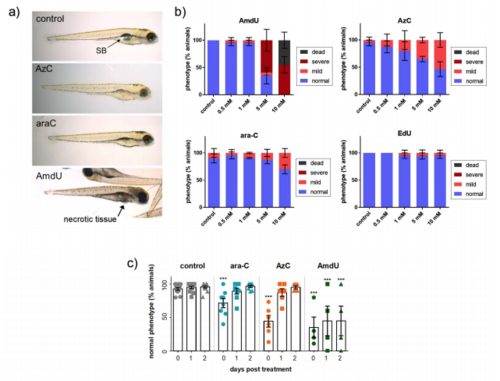Fig. S32
- ID
- ZDB-FIG-180611-51
- Publication
- Triemer et al., 2018 - Superresolution imaging of individual replication forks reveals unexpected prodrug resistance mechanism
- Other Figures
- All Figure Page
- Back to All Figure Page
|
Toxicity of nucleoside analogs in zebrafish larvae. (A) Representative photographs of 96 h old zebrafish larvae following 24 h incubations with 5 mM of each nucleoside analog. (B) Summary of data for 72 h old zebrafish larvae incubated with various concentrations (0.5 – 10 mM) of each nucleoside for 24 h and analyzed for phenotypic changes. Fish treated with AzC or ara-C lacked swim bladder inflation (corresponds to “mild” phenotype) whereas fish treated with AmdU displayed necrotic tissue and horizontal body positioning (corresponds to severe phenotype). (C) 72 h old zebrafish larvae were incubated with 10 mM of nucleoside analog for 24h, washed, and placed into media lacking nucleoside analog for up to 2 days (recovery). After a recovery period of 1 – 2 days, fish treated with ara-C and AzC regained a normal morphology, whereas AmdU-treated fish showed no signs of recovery. All experiments were repeated at least 3 times. Data are presented as mean ± SEM, *** p < 0.001 relative to controls; SB, swim bladder. |

